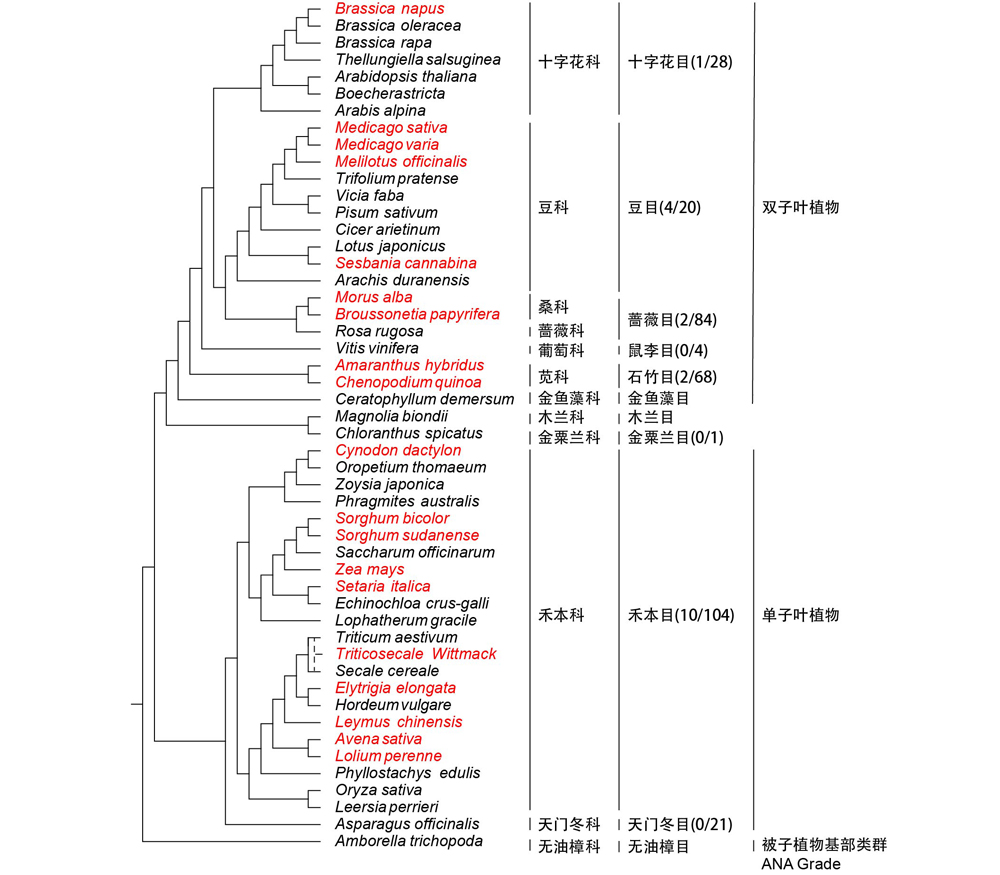

加强饲草基础生物学研究,保障饲草种业与国家大粮食安全
收稿日期: 2022-12-08
录用日期: 2022-12-10
网络出版日期: 2022-12-26
基金资助
国家重点研发计划(2022YFF1003200);山东省重点研发计划(重大科技创新工程)(2021SFGC0303)
Strengthen the Research of Forage Basic Biology to Ensure Forage Seed Industry and National Food Security
Received date: 2022-12-08
Accepted date: 2022-12-10
Online published: 2022-12-26
景海春 , 王台 , 林荣呈 , 曹晓风 , 种康 . 加强饲草基础生物学研究,保障饲草种业与国家大粮食安全[J]. 植物学报, 2022 , 57(6) : 719 -724 . DOI: 10.11983/CBB22275
Modern science and technology have just been entering the field of grass-based livestock husbandry, and “less input, low output and poor platform” restrict the development of forage breeding and industry in China. Although the development of grass-based livestock husbandry is ready to take off, the lack of scientific and technological innovation is difficult to ensure China’s food security; furthermore, there are few institutions and teams that focus on forage breeding research in China. Therefore, we organize the special issue ‘Forage Biology’, aiming to promote public awareness of the scientific and technological innovation, industrial development and national forage seed industry safety.

Key words: forage; seed industry; biology; grass-based livestock husbandry; great food security
| [1] | 曹丽雯, 卢蕊, 范吉标, 胡龙兴, 陈良 (2022). 新型饲草开发利用的基础生物学问题. 植物学报 57, 826-836. |
| [2] | 陈东辉, 孙莉莉, 张培奇, 范亚旭 (2022). 强化党建引领赋能乡村振兴. 农民日报. 12-02 (004). |
| [3] | 种康 (2022). 种康: 生物育种锻造农业“芯片”. https://www.cas.cn/zjs/202201/t20220119_4822791.shtml. 2022-12-09. |
| [4] | 高晶, 唐增, 李重阳 (2018). 中国城乡居民食物消费碳排放的对比分析. 草业科学 35, 2022-2030. |
| [5] | 郝怀庆, 张汝, 卢呈, 罗洪, 李志刚, 尚丽, 王宁, 刘智全, 吴小园, 景海春 (2022). 甜高粱育种研究进展及未来展望. 植物学报 57, 774-784. |
| [6] | 洪军, 苏红田 (2022). 我国牧草种质资源保护工作进展与发展思路. 植物学报 57, 725-731. |
| [7] | 侯新村, 腾珂, 郭强, 赵春桥, 高康, 岳跃森, 范希峰 (2022). 狼尾草属牧草研究进展. 植物学报 57, 814-825. |
| [8] | 金京波, 梁承志 (2022). 饲草基因组学研究进展. 植物学报 57, 732-741. |
| [9] | 金京波, 王台, 程佑发, 王雷, 张景昱, 景海春, 种康 (2021). 我国牧草育种现状与展望. 中国科学院院刊 36, 660-665. |
| [10] | 孔照胜, 杨文强, 王柏臣, 林荣呈 (2022). 豆科饲草碳氮高效固定、转运和同化利用研究进展. 植物学报 57, 764-773. |
| [11] | 李宏伟, 郑琪, 李滨, 李振声 (2022). 长穗偃麦草分子育种基础研究进展. 植物学报 57, 792-801. |
| [12] | 李强, 周道玮 (2018). 草地管理对土壤碳截获的影响. 安徽农业科学 46(23), 1-5, 8. |
| [13] | 谭文清, 陈军, 才宏伟 (2022). 黑麦草生物学研究进展. 植物学报 57, 802-813. |
| [14] | 王娜, 姜腾, 王彬锡, 牛丽芳, 林浩 (2022). 单倍体育种技术研究进展及其在苜蓿等豆科牧草中的应用. 植物学报 57, 756-763. |
| [15] | 王甜甜, 曹丽雯, 刘智全, 杨庆山, 陈良, 陈敏, 景海春 (2022). 黄河三角洲滨海草带建设的饲草基础生物学问题. 植物学报 57, 837-847. |
| [16] | 杨祯妮, 程广燕 (2022). 2021年奶类消费情况及2022年趋势研判. 中国乳业 (8), 2-5. |
| [17] | 张波, 任长忠 (2022). 燕麦基因组学与分子育种研究进展. 植物学报 57, 785-791. |
| [18] | 赵洪, 宋丽珍, 张玉娥, 程佑发, 薛勇彪 (2022). 饲草自交不亲和性与近交衰退. 植物学报 57, 742-755. |
/
| 〈 |
|
〉 |